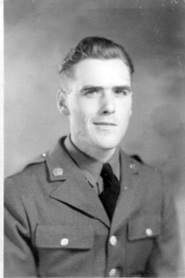Edward Floyd Steeg was born 27 October 1919, in Bismarck, North Dakota.
Edward attended schools in Stevens (aka North Sioux City, SD) and Jefferson, South Dakota.
Edward married Marcella Alice Olmstead on 18 May 1943, in Sioux City.
Their children (one born during the war and four after) are Edward Jr ‘Butch’, Gary, Valerie Harshfield, Velta Hickey, and Jackie Phillips.
Battalion division and company: 3 ARMD Div-32 ARMD Reg’t HD Q. Co. Ranks held Pvt., Pvt 1/c, Cpl, Sgt Tech 4 Engineers.
The food during service time was not too bad, plenty of it. There were entertainers from time to time. For ‘good luck’, we did a lot of praying. Had many friends, buddies who helped during my time away from home. I still have several buddies who survived. My most memorable event of that time was the death of President Roosevelt.
Service and experiences during that time, was good for me, but I wouldn’t want to do it again. It was very tough on the wife and parents. Service teaches the value of life and family.
“I was living in Steven, South Dakota (now known as North Sioux City), drafted 23 January 1942, into the army, entry into service at Fort Leavenworth, Kansas. The first days were lonesome and unpleasant. Boot Camp was a lot of K-P duty, marching and confusion. Didn’t have much choice, had to follow orders and get through it.
“I was stationed at Fort Knox, Kentucky, for basic training, then on to California for desert warfare in the Mohave desert, then to Virginia and Pennsylvania, and then to England.
“Campaigns and battles I served in: Normandy, Northern France, Rhineland, Central Europe, and the Ardennes. I was in the war for most of the four years that the war lasted.
“Sent overseas 5 September 1943, arrived Liverpool, then to Salisbury, Codford, and St. Mary, which were all in England. My job was to run the tele-switchboard. When I first arrived, I was in charge of tank and the crew in it and still did radio operation for the army/air force. I had seen lots of combat and casualties. The first bombing raid in London was thrilling until the building next door was demolished. Saw much of England, which was known only to me through history.
“In one instance, there was an Infantry Unit in the lead and four other tanks were sent down this long hill to help them. There wasn’t supposed to be any anti-tank guns in the area, but 4 tanks were taken out behind me, so I was the only tank to get through. We got to the bottom and hid behind a German Pill Box. We were to stay there until we received a smoke signal to return, which never came. We were trapped all that day, through the night and part of the next day, not realizing they must have pulled out during the night. We took some heavy fire during that time. For that time period, my unit was notified we were ‘missing in action’. The infantry unit, we were sent to protect, were able to make it back up that long hill with no enemy fire and join my unit. At least I was never a prisoner of war.
In between fighting to save alive, I wrote letters to family (the only way we had to stay in touch). Did a lot of praying. For entertainment, my buddies and I would have a few beers, see the sights and went to the movies. I’ve seen France, Belgium, Germany, Scotland, Holland and England during service time.
“When I arrived in France on Omaha Beach, it was rainy, lost lots of tanks and soldiers. Tough going! All in all, I served in the war three years and ten months. I got out in Camp Custer, Michigan. I received one Silver Star, the European Middle Eastern Theater Ribbon, the Good Conduct Medal, and a Certificate of Merit.
“When I returned from the war, I took a week off and then went back to work. I had worked for Rocklin Mfg before the war as a single spindle drill press operator. Did not go back to school, but did take a correspondence course. Went to work as a machinist, tool and dye maker. Worked for Rocklin Manufacturing and Concrete Pipe Machine.
“For hobbies, I enjoy fishing, hunting, camping, carpentry and building.”
Written and submitted by Edward F. Steeg.
![]()

